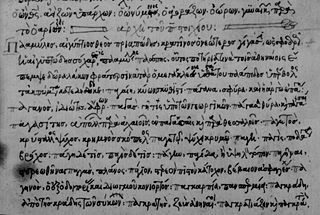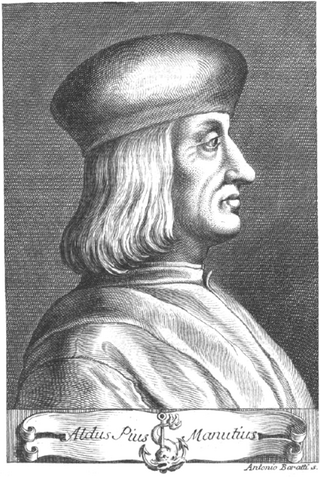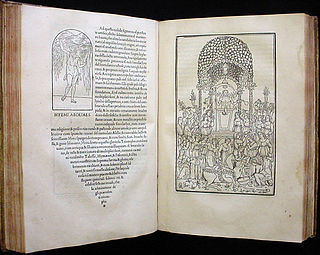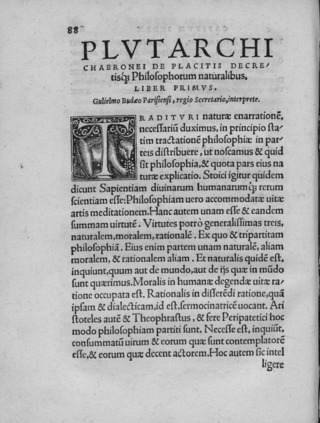
The Aldine Press was the printing office started by Aldus Manutius in 1494 in Venice, from which were issued the celebrated Aldine editions of the classics. The first book that was dated and printed under his name appeared in 1495.

Girolamo Aleandro was an Italian humanist, linguist, and cardinal.

Hesychius of Alexandria was a Greek grammarian who, probably in the 5th or 6th century AD, compiled the richest lexicon of unusual and obscure Greek words that has survived, probably by absorbing the works of earlier lexicographers.

Aldus Pius Manutius was an Italian printer and humanist who founded the Aldine Press. Manutius devoted the later part of his life to publishing and disseminating rare texts. His interest in and preservation of Greek manuscripts mark him as an innovative publisher of his age dedicated to the editions he produced. Aldus Manutius introduced the small portable book format with his enchiridia, which revolutionized personal reading and are the predecessor of the modern paperback book. He also helped to standardize use of punctuation including the comma and the semicolon.

William Grocyn was an human English scholar and friend of Erasmus.
Stephanus or Stephen of Byzantium was a Byzantine grammarian and the author of an important geographical dictionary entitled Ethnica (Ἐθνικά). Only meagre fragments of the dictionary survive, but the epitome is extant, compiled by one Hermolaus, not otherwise identified.
Quintus Smyrnaeus was a Greek epic poet whose Posthomerica, following "after Homer", continues the narration of the Trojan War. The dates of Quintus Smyrnaeus' life and poetry are disputed: by tradition, he is thought to have lived in the latter part of the 4th century AD, but early dates have also been proposed.

Hypnerotomachia Poliphili, called in English Poliphilo's Strife of Love in a Dream or The Dream of Poliphilus, is a book said to be by Francesco Colonna. It is a famous example of an incunable. The work was first published in 1499 in Venice by Aldus Manutius. This first edition has an elegant page layout, with refined woodcut illustrations in an Early Renaissance style. Hypnerotomachia Poliphili presents a mysterious arcane allegory in which the main protagonist, Poliphilo, pursues his love, Polia, through a dreamlike landscape. In the end, he is reconciled with her by the "Fountain of Venus".
This article contains information about the literary events and publications of 1501.
GrattiusFaliscus was a Roman poet who flourished during the life of Augustus. He is known as the author of a Cynegeticon, a poem on hunting.
Gadfly most commonly refers to:

Ancient Greek literature is literature written in the Ancient Greek language from the earliest texts until the time of the Byzantine Empire. The earliest surviving works of ancient Greek literature, dating back to the early Archaic period, are the two epic poems the Iliad and the Odyssey, set in an idealized archaic past today identified as having some relation to the Mycenaean era. These two epics, along with the Homeric Hymns and the two poems of Hesiod, the Theogony and Works and Days, constituted the major foundations of the Greek literary tradition that would continue into the Classical, Hellenistic, and Roman periods.
Robert Geoffrey Trease FRSL was a prolific British writer who published 113 books, mainly for children, between 1934 and 1997, starting with Bows Against the Barons and ending with Cloak for a Spy in 1997. His work has been translated into 20 languages. His grandfather was a historian, and was one of the main influences on his work. He is best known for the children's novel Cue for Treason (1940).
Julius Pollux was a Greek scholar and rhetorician from Naucratis, Ancient Egypt. Emperor Commodus appointed him a professor-chair of rhetoric in Athens at the Academy — on account of his melodious voice, according to Philostratus' Lives of the Sophists.
Alciphron was an ancient Greek sophist, and the most eminent among the Greek epistolographers. Regarding his life or the age in which he lived we possess no direct information whatsoever.

The Moralia is a group of manuscripts written in Ancient Greek dating from the 10th–13th centuries but traditionally ascribed to the 1st-century scholar Plutarch of Chaeronea. The eclectic collection contains 78 essays and transcribed speeches. They provide insights into Roman and Greek life, but they also include timeless observations. Many generations of Europeans have read or imitated them, including Michel de Montaigne, Renaissance Humanists and Enlightenment philosophers.

Bows Against the Barons is a 1934 children's novel by the British author Geoffrey Trease, based on the legend of Robin Hood. It tells the story of an adolescent boy who joins an outlaw band and takes part in a great rebellion against the feudal elite. Trease's first novel, Bows Against the Barons marks the start of his prolific career as a historical novelist. It is notable for reinterpreting the Robin Hood legend and revitalizing the conventions of children's historical fiction in 20th-century Britain.
Arsenius Apostolius was a Greek scholar who lived for a long time in Venice. He was also bishop of Monemvasia in the Peloponnese.

Festina lente or speûde bradéōs is a classical adage and oxymoron meaning "make haste slowly". It has been adopted as a motto numerous times, particularly by the emperors Augustus and Titus, then later by the Medicis and the Onslows.
Johannes Cuno was a Dominican humanist and early greek scholar in the Germanophone region. He was also a translator from the Greek language and collector of manuscripts and books. While living in Basel, he assisted the printer Johann Amerbach and was teacher for the Greek language to Amerbachs sons and Beatus Rhenanus.










